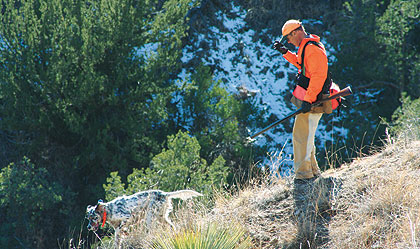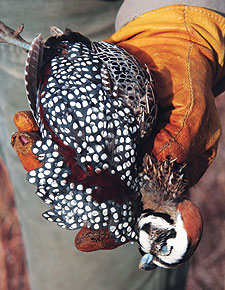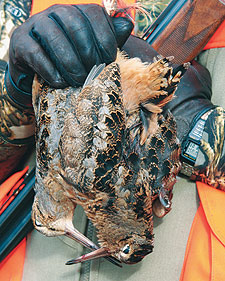Which gamebirds hold best for pointing dogs? Here are the author's nominations.
By Dave Carty
Long ago, as a result of reading too many outdoor magazines at an age prior to forming what occasionally passes for my critical faculties, I got the idea that gamebirds "held" for a point--that is, sat patiently in one spot while the dog stood sentinel a few feet away, eyes bulging and flared nostrils quivering, until the stalwart gunner could amble up and reduce the bird to possession.
 Mearns quail typically inhabit cover with a lot of "vertical," but their tight-holding characteristics make them ideal for pointing dogs. |
I cut my teeth on bobwhites in southern Iowa, back when there actually were bobwhites in southern Iowa (and, with regard to the 2008 floods, back when there was a southern Iowa that wasn't under water), so sometimes it actually worked out that way. I also shot up the local woods with never a thought to gaining permission and shamelessly poached bass from county farm ponds, but to hell with that. Those were the good old days.
In the 40 years since then, I've been around the block a few times, chasing various species of gamebirds from the cliffs of southern Oregon to the woods of Wisconsin, most of which ran like their tails were on fire, all singularly adept at not winding up in my gamebag. And yet, despite it all, this truism rings through: Yes, Virginia, there really are birds that hold for a point.
But the list of runners is getting pretty gol-darn extensive. It includes Huns, sharptailed grouse, chukars, all the desert quail and ruffed grouse, perhaps the worst of the lot. When was the last time you saw a painting of a setter sticking a running grouse? And don't even get me started on pheasants.
Some of these little home wreckers can give a young dog fits, which can lead to all kind of minor complexes he'll have to sort out later. So it's nice to let a youngster learn the ropes on birds that behave the same way the pen-raised pigeons you've been planting for him all summer behave: like gentlemen.
The first bird on my short list, not surprisingly, is the bobwhite quail. Bobwhites have a permanent home in my romantic heart, not least because they were the first gamebirds I ever hunted. Back in the '60s, there was a covey near every woodlot, and as clueless as we were in those days, my dad and I could still usually find a covey or two in a morning's hunt.
Then the fun began. The birds would scatter into the woods, each holding tight as ticks on the leafy detritus of the forest floor, before rocketing out from under my Brittany's nose to dodge around the hardwoods. Because I was too green to know how difficult that kind of shooting was supposed to be, I actually hit a bird now and then with my single-shot .410.
That happened rarely enough that I can still remember my awe as I examined each one, rolling it over and over in my freckled hands, then folding it gently into the back pocket of my canvas vest. For the rest of the hunt I'd reach back every few minutes and make sure my bird was still there.
 The male Mearns quail wears unique harlequin markings. |
It's one of the great failures of our farm programs that most of those precious little quail have vanished. There is still good hunting in Kansas and Oklahoma and I've been told that parts of Nebraska still have birds, but my few trips back to the Midwest have been mostly fruitless and discouraging. Texas, of course, has bobwhites, but who can afford to hunt there? Still, I haven't given up; doing so would be to abandon part of who I used to be.
My last trip for bobs was eight or nine years ago to southeastern Kansas. It had rained buckets prior to our arrival, and as a consequence we spent most of the trip sloshing through mud and standing water. Birds were scarce, but over the course of four or five days we managed to put up a covey or two a day. One afternoon, my buddy Chris Ricardi and I found my footsore and gray-muzzled Brittany, Fancy, locked up and peering intently into some scrubby cottonwoods on the rim of a shallow wash. We marched past the little dog like good upland soldiers, but no birds.
Fancy hadn't moved. I inched back and stomped the grass in front of her. Again, nada. Finally, one of us stumbled into the birds, which went up in a thrumming roar a few feet from the little Brit's pink nose. We must have passed within inches of them. That was toward the end of Fancy's long life, and I always thought it fitting that the quail stood on tradition that trip, holding tight for every one of her points.
Jog a few hundred miles north, and by mid October you'll find the boggy alders full of woodcock, perhaps the most gentlemanly gamebirds of the lot, which makes it all the more startling on those rare occasions when they run. One day, my setter Scarlet flash-pointed in a Wisconsin swamp, and a second later I saw a flash of brown scuttle out from under her nose and dart behind a log.
Thinking she'd put up a rabbit--we'd run into several snowshoe hares on that trip--I moved up, my shotgun casually slung in the crook of my arm. A second later a doodle darted out and, tottering like a tiny bowling pin, lurched into the alders and disappeared. This was a bad strategic move, as it turned out. It chose to hide just a few feet from where my buddy stood, and he subsequently flushed and shot it.
My youngest setter, Hanna, pointed her first woodcock when she was nine months old. Although she'd never seen or scented a timberdoodle in her life, she held that bird like a seasoned pro. A day later she ran away and I spent one of the longest half hours of my life chasing her down. That took some of the edge off my euphoria, but I finished the trip with a spring in my step. Only woodcock will behave that well for a completely green puppy.
 Woodcock are perhaps the most "gentlemanly" of all gamebirds. |
With respect to their willingness to sit tight, there doesn't seem to be much common ground among the quails, with bobwhites holding down the mannered end of the family tree and the desert birds --valley, Gambel's and scaled quail--whooping it up with their reprobate friends down at the track. I haven't hunted Gambel's yet, and my experience with scaled quail h
as been limited to a couple trips on which I zeroed out both times. But I've been chasing valley (California) quail sporadically on chukar hunts for several years now, and they give away nothing to the other two desert birds in the fleet-of-foot department. Yes, the singles do hold once you break up the covey, but getting the covey into the air can be a chore.
I once spent 20 minutes chasing a dozen birds around and around a seep, only to have the size of the covey dwindle to a fraction of what the dog and I started out with. By the time she pinned them and I finally put them up within range, "them" was one bird. I shot that little sucker and felt pretty damn good about it, too.
Mearns quail, on the other hand, are birds of a different feather. They're a mountain bird, and most of the country they live in inclines toward the vertical. The climb steals your breath away and rockets your heart rate into the anaerobic zone, but once you catch your breath, you'll discover that the birds your dog is pointing are still there, right under his nose.
Over and over during the last several years, I've been struck by how much Mearns quail resemble the bobwhites of my misspent youth. The two look nothing alike, of course, and the Mearns' clownish masks weren't all that appealing to me at first. But they hold like bobs, covey like bobs, and scatter into singles like bobs.
Find a covey of Mearns one day near the grove of blue oaks at the head of a ravine, and--like bobs--there's a good chance they'll be waiting for you when you return the following week, their turkey-like scratchings in the moist soil around the base of the tree proof they're still around. After my first few days of Mearns action, I began reconsidering their looks--these were handsome fellows after all. After 20-some years of chasing Huns back home in Montana, I can't begin to tell you how refreshing it is to flush birds from under your dog's nose, birds that actually will hold between his paws.
Even Mearns aren't perfect, though. My lanky buddy John Palmer and I once chased a covey nearly a hundred yards straight up the side of a mountain, his setter Sweetgrass alternately flash-pointing and creeping, until we topped out on the treeless flats above. With no more cover for them to maneuver in, the birds made a break for it.
One hen ran out in front of me and then launched herself into the air behind the only tree within 50 yards. Another bird sprinted out in front of John, running to beat the band, and then flew back downhill. We missed them both. Thank God running Mearns aren't common; I'd have to find another vice to get me back into the glorious country they live in.
The last bird on my list is a bird few hunt and many don't consider worthy of a pointing dog: blue grouse. But I'm here to tell you that blue grouse hold for a point, period. How they hold for a point is where I start massaging the semantics.
Those of you who have hunted any of the birds I've already discussed know how rare it is to see one on the ground; it's rare because they burrow into cover, doing their best to hide. Not so with the guileless blues. Blue grouse seem to make no attempt to hide whatsoever; instead, they parade around in front of a dog like so many curious chickens, craning their necks to get a better look and clucking nervously under their breaths. When the anticipation gets to be too much, they launch themselves ponderously into the air, and that's where the fun begins.
They may be slow from zero to 60, but blues invariably fly downhill, and once they get a head of steam going, I can't think of a faster bird. So no, they don't "hold" in the classic sense, but I've yet to see one run out from under a point, either. Even wing-tipped blues rarely run, making them an excellent choice for young dogs that are still working the kinks out of their retrieving technique.
Of course, just about all the gamebirds will hold on occasion. I sometimes run my dogs on Huns early in the year, when the birds are paired up and hold wonderfully. I've had plenty of ruffed grouse and even a few pheasants come up from under my boots. And once you break up a covey of chukars, they can provide superb singles shooting--if you can get to them.
But bobwhites and the rest have something special--a willingness to sit patiently while a trembling puppy discovers its nose and an old dog like me remembers how it used to be, back when the whole world was a bird dog, a single-shot .410, and a gamebird that held like a gentleman.






